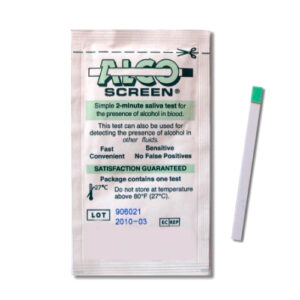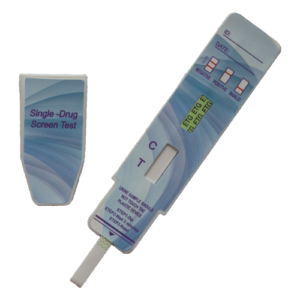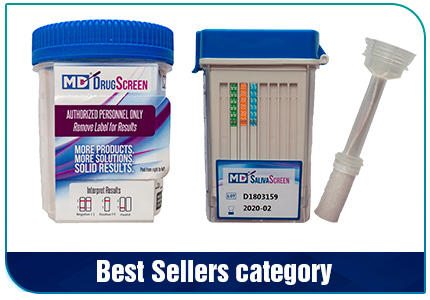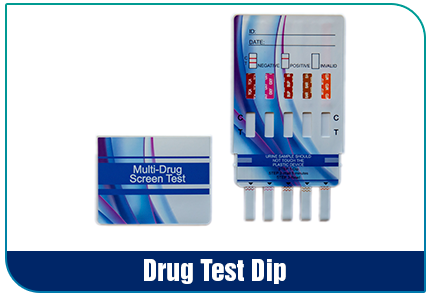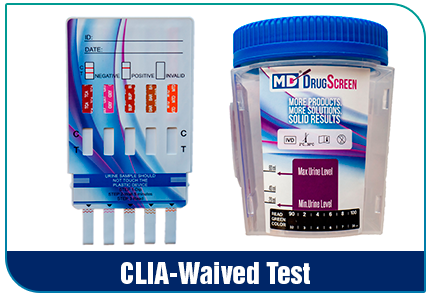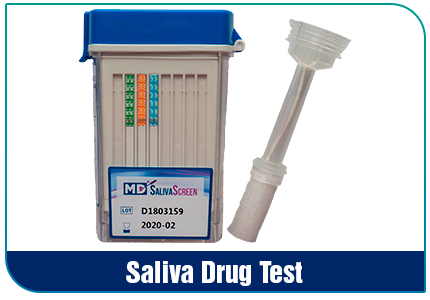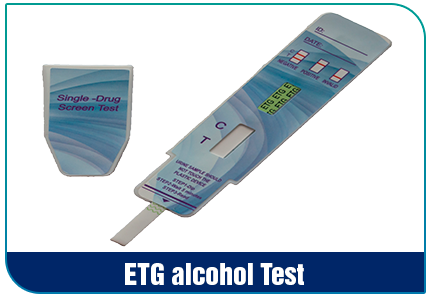Alcohol Tests
-
ETG ALCOHOL TEST KIT
$7.95
What is an Alcohol Test?
An alcohol test is a method of determining the blood alcohol concentration (BAC) in a person's system. Alcohol tests are commonly used to check if a person is under the influence of alcohol, particularly when they are operating a vehicle. There are several different methods for conducting alcohol tests, including breathalyzers, blood tests, and urine tests.
Alcohol tests are an important part of many companies' safety protocols, but understanding the different types and how to properly administer them can be tricky. From breathalyzers, to blood alcohol content (BAC) tests, and urine tests there are a variety of options available for accurately measuring someone's level of intoxication. Each type has its own unique benefits that should be considered when deciding which one is best suited for your needs. In this article we'll explore the various types of alcohol tests, discuss their advantages and disadvantages, provide tips on choosing the right test for you and explain proper administration procedures once it’s chosen. Finally, we will cover what actions should be taken after administering an alcohol test so everyone involved stays safe and informed.
Breathalyzers are the most commonly used method, and involve the person blowing into a device that measures their BAC. Blood tests and urine tests are less commonly used, but may be utilized in more serious cases or when breathalyzers are not available. Or for various other reasons when they may prove to be more beneficial. The legal limit for BAC varies by location and type of license held, and it is illegal to operate a vehicle with a BAC above the legal limit in most places. Alcohol tests may be conducted by law enforcement during traffic stops or when suspecting impaired driving.
How long Does Alcohol Stay In your System?
Alcohol can remain in a person's system for several hours after they stop drinking, so it is possible to test positive for alcohol even if the person has not been drinking at the time of the test. Factors such as a person's weight, gender, age, time between drinks, water consumed, and how much they have eaten can affect their BAC.
In general, alcohol is metabolized at a rate of about 0.016% BAC per hour, which means that it takes about one hour for the body to metabolize one standard drink (e.g. a 12-ounce beer, a 5-ounce glass of wine, or a 1.5-ounce shot of liquor). Again this is not to be used as an exact way to judge how long alcohol will remain in your system. It is highly variable based upon each different situation.
Some people may metabolize alcohol faster or slower than the average rate, and other factors such as a person's metabolism, hydration level, and the presence of certain medications can also affect the rate of metabolism.
As a general rule, it takes about 2 to 3 hours for a person to metabolize one standard drink. However, it is important to note that alcohol can remain in a person's system for several hours after they stop drinking, and it is possible to test positive for alcohol even if the person has not been drinking at the time of the test.
How Accurate are Alcohol Tests?
The accuracy of alcohol tests can vary depending on the type of test and the specific circumstances of the person being tested. In general alcohol screening tests are considered a reliable indicator of BAC. Some factors that can affect the accuracy of alcohol tests include the presence of certain medications, mouthwashes, and breath fresheners, which can interfere with the accuracy of breathalyzers but have no effect on urine or saliva alcohol tests. Factors such as a person's age, weight, and gender can also affect the BAC in their system.In general, alcohol tests are considered to be reliable indicators of BAC, but it is always a good idea to confirm the results with additional confirmatory testing when a non-negative result occurs.
Does Alcohol Show Up On a Drug Test
Alcohol is a commonly used substance that is not typically included in standard drug tests, which usually screen for illicit drugs such as marijuana, cocaine, amphetamines, and opioids. However, alcohol can be detected in certain types of drug tests, such as breath and saliva.
Breathalyzer tests, which measure the amount of alcohol in a person's breath, are commonly used by law enforcement to determine a person's level of impairment. These tests can detect alcohol consumption within the past 24 hours.
Urine tests do not detect alcohol, but they can detect a byproduct of alcohol called EtG (ethyl glucuronide) in a person's system for up to 80 hours after the last use of alcohol. Saliva tests can also detect EtG for up to 24-48 hours after the last use.
It's important to note that alcohol can be a contributing factor in accidents or other incidents, employers or other parties may have specific policies or regulations that require testing for alcohol. So standard drug tests do not typically screen for alcohol, but breath, urine, and saliva tests can be used to detect alcohol use. The detection window varies depending on the type of test, but it is generally short, ranging from 12 hours to 80 hours after the last use.
Types of Alcohol Tests
Breathalyzer Tests: Breathalyzer tests are the most common type of alcohol test used today. They measure the amount of alcohol in a person’s breath and provide an accurate indication of their blood-alcohol content (BAC). The results from a breathalyzer test can be used to determine if someone is legally intoxicated or not. Advantages of using this type of test include its convenience, accuracy, and cost effectiveness. Disadvantages include potential false positives due to certain medical conditions or medications that may interfere with the results.
Blood Tests: Blood tests are another way to measure BAC levels accurately and quickly. This method requires taking a sample of blood from the individual being tested, which is then analyzed for alcohol content in a laboratory setting. While more invasive than other methods, it provides highly reliable results that cannot be affected by any external factors such as mouthwash or food particles in the mouth. The main disadvantage is that it requires specialized equipment and trained personnel to administer correctly.
Urine tests: are also commonly used for measuring alcohol levels, but they tend to be more accurate than either breathalyzers or blood tests at measuring recent consuption rather than current intoxication level. Urine alcohol tests are a common method for detecting recent alcohol consumption in a workplace setting. The process involves collecting a sample of urine from the individual and analyzing it for the presence of alcohol. Results are typically available within a short period of time, usually a few minutes.
Saliva Tests: The results of a saliva alcohol test can indicate recent alcohol consumption and are typically considered less invasive than blood or breath tests. The test involves taking a sample of saliva from the person being tested and analyzing it for the presence of alcohol. The results are usually available within a few minutes. However, these tests are not as accurate as blood tests and have a lower detection limit, meaning that they may not be able to detect low levels of alcohol consumption.
Different types of alcohol tests can provide accurate results to help companies ensure safety and compliance. By understanding the benefits of alcohol testing, companies can better understand how these tests can be used in their organization.
Benefits of Alcohol Testing
Alcohol testing can be a valuable tool for companies to ensure safety and compliance. Testing can help deter underage drinking and driving, ensure employee safety in the workplace, and monitor compliance with court orders or probation requirements.
Deterring Underage Drinking and Driving: Alcohol testing is an effective way to discourage young people from engaging in dangerous activities such as underage drinking and driving. Companies that require employees to submit to alcohol tests may also find it beneficial when hiring new staff members who are under 21 years of age. This type of screening helps employers identify potential risks before they become liabilities.nn
Ensuring Employee Safety in the Workplace: Alcohol testing can also help protect employees by ensuring that those who work around hazardous materials or machinery do not have any traces of alcohol in their system while on duty. This type of screening is especially important for jobs where impaired judgment could lead to serious injury or death, such as operating heavy machinery or working with hazardous chemicals. It’s also beneficial for employers who want to reduce liability risks associated with workers’ compensation claims due to accidents caused by intoxication on the job site.
Alcohol testing provides many benefits, from deterring underage drinking and driving to ensuring employee safety in the workplace. By understanding these benefits, you can make an informed decision on which type of alcohol test best suits your needs.
How to Choose the Right Alcohol Test for Your Needs
When it comes to choosing the right alcohol test for your needs, there are several factors to consider. The type of test needed for a particular situation is one of the most important considerations. Breathalyzer tests are often used in situations where an individual’s blood alcohol content (BAC) needs to be quickly determined, such as when determining if someone is driving under the influence or at work while intoxicated. Blood tests can provide more accurate results than breathalyzers and are typically used in legal proceedings or medical evaluations. Urine tests may also be necessary depending on the situation and can provide a longer window into an individual’s BAC history than either breathalyzers or blood tests alone, testing up to 80hrs if alcohol was heavily consumed.
Cost and availability of supplies and equipment should also be taken into account when selecting an alcohol test. Breathalyzers require consumable items like mouthpieces that need to be replaced after each use, so having access to replacement parts is essential for any organization using them regularly. Similarly, urine and saliva testing requires collection kits. You can save money over time by by purchasing in bulk quantities from an online vendor such as Halux Diagnostic.
Choosing the right alcohol test for your needs is essential to ensure accurate results and a successful testing process. To ensure that you have chosen the best option, follow the steps outlined in this article. Next, we will discuss how to properly administer an alcohol test.
How to Administer an Alcohol Test Properly
Administering an alcohol test properly is essential for ensuring accurate results and following all relevant laws. It requires careful preparation, knowledge of the testing process, and attention to detail.
Prepare the Testing Area and Materials Needed Ahead of Time: Before administering an alcohol test, it’s important to ensure that you have all the necessary materials on hand. This includes a breathalyzer device or other testing equipment, collection cups or swabs for collecting samples, paperwork for recording results, and any additional supplies needed such as gloves or masks. Additionally, make sure that the area where you will be conducting tests is clean and well-lit so that you can easily see what you are doing.
Once everything is in place, it's time to begin collecting samples from each individual being tested. Make sure to follow proper protocols when doing this, such as using sterile swabs or collection cups if applicable, wearing gloves, labeling each sample with identifying information and documenting results accurately on paper forms provided by your employer or organization responsible for administering tests.
Finally, make sure that all relevant laws are followed during testing procedures such as notifying individuals before they are tested of their rights under applicable state law; obtaining written consent from those being tested prior to beginning any tests; providing privacy while taking samples; storing collected samples securely until analysis can be completed; disposing of used materials appropriately after testing has been completed; and maintaining confidentiality regarding test results unless otherwise required by law.
Administering an alcohol test properly is essential for obtaining accurate results and following all relevant laws. By following the steps outlined in this article, companies can ensure they are taking the necessary precautions when conducting alcohol tests. Now that you know how to administer an alcohol test, let's take a look at what to do after it has been administered.
What to Do After an Alcohol Test Is Administered
After an alcohol test is administered, it is important to analyze the results and take appropriate action based on findings. Depending on the type of test conducted, this could include notifying law enforcement or a court officer if necessary. It is also important to document all steps taken during testing process in order to ensure accuracy and compliance with relevant laws. This includes recording any observations made by testers as well as collecting samples properly and securely storing them until they can be analyzed.
Finally, providing necessary support services after an alcohol test may be required depending on the situation. If someone tests positive for alcohol consumption, they should receive counseling or other forms of assistance in order to help them address their problem and reduce future risk of harm from drinking-related activities such as driving under the influence (DUI). Additionally, employers may need to provide additional training or education about workplace safety policies related to alcohol use if employees are found violating those policies through testing results.
FAQs in Relation to Alcohol Tests
What kind of tests are there for alcohol?
There are several types of tests for alcohol, including breathalyzers, blood tests, and urine tests. Breathalyzers measure the amount of alcohol in a person's breath and can be used to determine if someone is legally intoxicated. Blood tests measure the amount of alcohol in a person's bloodstream and can provide more accurate results than breathalyzers. Urine tests detect the presence of ethyl glucuronide (EtG) or ethyl sulfate (EtS), which are byproducts created when the body breaks down alcohol. These metabolites remain in a person’s system for up to 80 hours after drinking, making them useful for determining recent consumption of alcohol.
How long after drinking can you pass an alcohol test?
The amount of time it takes for an individual to pass an alcohol test after drinking depends on a variety of factors, including the type and amount of alcohol consumed, body weight, gender, and metabolism. Generally speaking, most people can expect to pass an alcohol test within 12 hours after their last drink. However, some individuals may take up to 24 hours or more depending on the above factors. It is important to note that even if you have passed a breathalyzer test or other form of drug testing at one point in time following your last drink, there is still no guarantee that you will not fail a subsequent test due to residual traces of alcohol in your system.
Can I pass an alcohol test in 2 days?
No, it is not possible to pass an alcohol test in two days. Alcohol can remain in the body for up to 72 hours after consumption and will still be detectable on a urine drug test. Depending on how much was consumed, it could take longer than two days for all of the alcohol to leave your system. To ensure that you pass an alcohol test, abstain from drinking any alcoholic beverages at least three days prior to taking the test.
What is considered a positive alcohol test?
A positive alcohol test is a result that indicates the presence of alcohol in an individual's system. This can be determined through breath, saliva, urine, or blood tests. The amount of alcohol present must exceed the established cutoff level for the test to be considered positive. Depending on the type of test used and local laws, this cutoff level may vary from 0.02% BAC (blood alcohol concentration) up to 0.08%. If an individual’s results are above this limit they will be considered to have tested positively for alcohol consumption.
Conclusion
In conclusion, alcohol tests are an important tool for companies that need to ensure the safety of their employees and customers. There are a variety of different types of alcohol tests available, each with its own set of benefits. It is important to choose the right type of test for your needs and administer it properly in order to get accurate results. After administering an alcohol test, it is also essential to take appropriate action based on the results. By understanding these steps and using quality alcohol tests, companies can make sure they have taken all necessary precautions when it comes to testing for alcohol use.
Alcohol tests are an important tool for identifying potential alcohol-related issues. They can be used to detect the presence of alcohol in individuals and identify when it is present at dangerous levels. By investing in quality drug testing supplies, we can ensure that accurate results are achieved quickly and efficiently, helping protect those around us from the risks associated with excessive drinking or driving under the influence. Let's take action now by equipping our communities with reliable alcohol test kits so we can help reduce instances of drunk driving and other related dangers! If you have an questions before you order your drug and alcohol testing supplies contact us!


